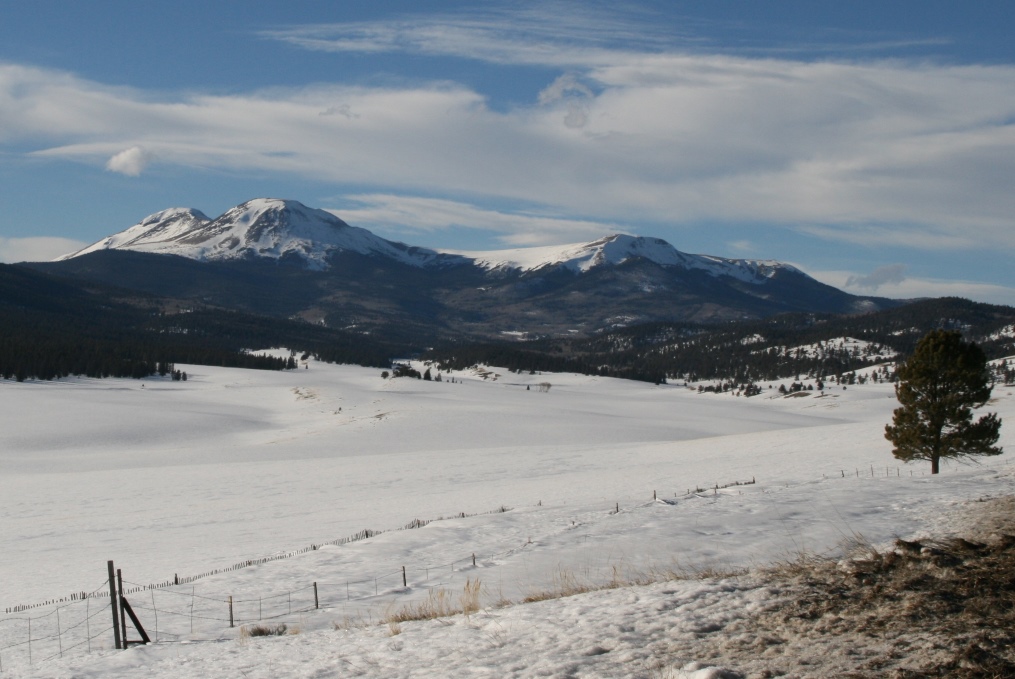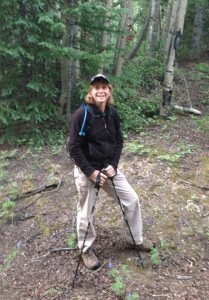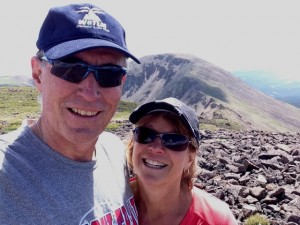Posts Tagged ‘VHF’
 West Buffalo Peak (W0C/SP-018)
West Buffalo Peak (W0C/SP-018)
Buffalo Peaks are a pair of 13er summits that stick up quite prominently on the west side of South Park. West Buffalo peak is the taller of the pair (13,326 feet) and the SOTA summit (W0C/SP-018). I’ve had my eye on these peaks for a while, wanting to do a SOTA activation. Here’s a winter view of the summits from the south near Trout Creek Pass.
There’s quite a bit of good information on the peaks at SummitPost.org.
Joyce K0JJW and I hiked in from the north, off of Buffalo Peaks Road (FS 431). The trailhead is not marked and is easy to miss but this trip report on the 13ers.com web site is very helpful. Pay special attention to the photo of the trailhead. This trip report describes doing both East and West Buffalo in a bit of a loop. We opted to focus on just West Buffalo, skipping East Buffalo.
Here’s my favorite hiking partner on the trail near the trailhead. The “trail” is not very well marked, following various old logging roads. We roughly followed the route indicate on 13ers.com. Once we cleared the trees we had a good view of both peaks and aimed for West Buffalo. We did make a critical error by going for the summit too early and got onto some very steep talus. Not fun. So the main route finding advice I am going to provide is make sure you approach the summit from the (more) gentle saddle on the northwest side. I marked this waypoint (N 38.99444, W 106.12866) as a good point to aim for on the way up so that you stay far enough west.
Once on the summit, I worked the following stations on 146.52 MHz: KD0MRC, KJ6NES, AF5KS, W9GYA, KE0DMT, W0BV and K5UK.
On the descent we stayed west of the route marked on the 13ers.com trip report with the intent of having an easier route. However, mostly what we did was encounter additional off trail hiking, so that is probably not recommended. It would have been better to just retrace our ascent route. Eventually, we found a different trail that led back to FS 431, popping out about a quarter mile west of where we parked. I had the location of our Jeep marked in the GPS, so it was easy to backtrack to the vehicle.
This was the first SOTA activation for West Buffalo Peak, so it was great to get that in the log. Thanks to everyone that got on the air to work me.
73, Bob K0NR
The post West Buffalo Peak (W0C/SP-018) appeared first on The KØNR Radio Site.
 Summits On The Air at Central States VHF
Summits On The Air at Central States VHF
Recently I had the opportunity to speak about portable, mountaintop VHF operating at the Central States VHF Society Conference in Denver. A key part of my presentation was the Summits On The Air program, portable VHF equipment, VHF contests and other operating events.
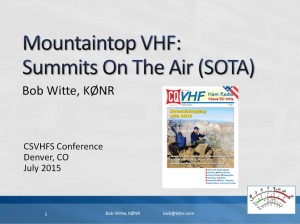 The presentation slides are available here in pdf format. I also submitted a paper on the same topic to the conference a paper on the same topic to the conference proceedings.
The presentation slides are available here in pdf format. I also submitted a paper on the same topic to the conference a paper on the same topic to the conference proceedings.
73, Bob K0NR
The post Summits On The Air at Central States VHF appeared first on The KØNR Radio Site.
 Coming Soon: 146.52 MHz in ARRL VHF Contests
Coming Soon: 146.52 MHz in ARRL VHF Contests
 I’ve been known to
I’ve been known to whine complain comment about the prohibition against using 146.52 MHz during ARRL radio contests. For example, see The One Frequency You Should Never Use on Field Day and Mt Herman: SOTA plus VHF Contest.
During my presentation on Mountaintop VHF for SOTA at the Central States VHF Society Conference in Denver today, I mentioned this is an issue. Basically, I pointed out that Summits On The Air (SOTA) operators often default to the 2m fm calling frequency, which is prohibited for use in the ARRL contests. This gets in the way when mountaintop stations do a combination SOTA and VHF Contest operation.
During my presentation, Brian Mileshosky N5ZGT, ARRL Director of the Rocky Mountain Division, reported that the ARRL has decided to remove the prohibition of 146.52 MHz in VHF contests. It will take some time for this to work its way into the actual rules, so stayed tuned for further developments.
This is great news…a cleanup of an unnecessary impediment to VHF contesting. Now, will the CQ Worldwide VHF Contest do the same?
73, Bob K0NR
The post Coming Soon: 146.52 MHz in ARRL VHF Contests appeared first on The KØNR Radio Site.
 2015 Colorado 14er Event
2015 Colorado 14er Event
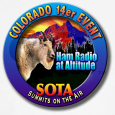 Amateur Radio operators from around Colorado will be climbing many of Colorado’s 14,000-foot mountains and Summits On The Air (SOTA) peak to set up amateur radio stations in an effort to communicate with other radio amateurs across the state and around world. Join in on the fun on the first full weekend in August and see how many of the mountaintop stations you can contact. The prime operating hours are on Sunday August 2nd from 9 AM to noon local time (1500 to 1800 UTC), but activity can occur throughout the weekend.
Amateur Radio operators from around Colorado will be climbing many of Colorado’s 14,000-foot mountains and Summits On The Air (SOTA) peak to set up amateur radio stations in an effort to communicate with other radio amateurs across the state and around world. Join in on the fun on the first full weekend in August and see how many of the mountaintop stations you can contact. The prime operating hours are on Sunday August 2nd from 9 AM to noon local time (1500 to 1800 UTC), but activity can occur throughout the weekend.
Now including Summits On the Air (SOTA), which adds over 1700 potential summits! If you aren’t up to climbing a 14er, there are many other summits to choose from (with a wide variety of difficulty). See the W0C SOTA web page at w0c-sota.org
Radio operators who plan to activate a summit should set an “Alert” on the SOTAwatch.org web site. To subscribe to the “ham14er” email list, visit the yahoo groups site at http://groups.yahoo.com/group/ham14er/. Also, be sure to check out the event information at http://www.ham14er.org
Frequencies used during the event
Activity can occur on any amateur band including HF and VHF. The 2m fm band plan uses a “primary frequency and move up” approach. The 2m fm primary frequency is 147.42 MHz. At the beginning of the event, operators should try calling on 147.42 MHz. As activity increases on that frequency, move on up the band using the 30 kHz steps. Don’t just hang out on 147.42 MHz…move up! The next standard simplex frequency up from 147.42 MHz is 147.45 MHz, followed by 147.48, 147.51, 147.54 MHz.
Frequency (MHz) 147.42 Primary 2m FM Frequency, then up in 30 kHz steps 223.5 Primary 222 MHz FM frequency 446.000 Primary 70 cm FM frequency 446.025 Alternate 70 cm FM frequency 52.525 Primary 6m FM frequency 144.200 2m SSB calling frequency 50.125 6m SSB calling frequency 14.060 20m CW Frequency 14.345 20m SSB Frequency 18.092 17m CW Frequency 18.158 17m SSB Frequency 21.060 15m CW Frequency 21.330 15m SSB Frequency 28.060 10m CW Frequency 28.350 10m SSB Frequency Other Bands/Modes: Standard calling frequencies and/or band plans apply.
Warning: Climbing mountains is inherently a dangerous activity. Do not attempt this without proper training, equipment and preparation.
Sponsored by The Colorado 14er Event Task Force
The post 2015 Colorado 14er Event appeared first on The KØNR Radio Site.
 VHF NFD 2015
VHF NFD 2015
The 2015 annual VHF national field day is now officially finished. So what’s the news?
 Firstly I managed so excellent DX from the comfort of my own shack.
Firstly I managed so excellent DX from the comfort of my own shack.
DX you say?
Yep 3 countries
Wow(?)…well yes they were EI,GM and GW so not exactly a long way but DX none the less.
Uhh?
Well yes, if the bands are normally silent and there’s not a station to be heard then the end of the village is DX.
But if there’s a bit of activity as there was this weekend then its always nice to work a few stations in other countries. But what would be really nice is to hear this level of activity on the bands regularly, and there to be rag chewing alongside contesting.
The ‘official entry’ from Workington was camped up on Corney Fell. I arrived too late to help get set up due to domestic duties but the photo’s didn’t do the conditions justice. There was a good 30+ mph wind up there and that 2m antenna was flapping about a lot. Hence the extra guy .
The VHF bands are XYL friendly in my house as the antenna’s are smaller, can be overlooked (on occasion) and don’t warrant the usual response of ‘What the hell is that doing there?’ and ‘ How long do you intend on keeping that thing there?’ The answer to both of these questions is to mumble a bit and pretend to be busy doing something important.
don’t warrant the usual response of ‘What the hell is that doing there?’ and ‘ How long do you intend on keeping that thing there?’ The answer to both of these questions is to mumble a bit and pretend to be busy doing something important.
So here’s a plea. Don’t make me take down this antenna, or worse still turn it vertically for FM. I’d quite like to work stations regularly on VHF SSB or even CW. Remember to switch the rig on, look for IO84 square and break the silence. A response to one contester today on 70cms was ‘That woke me up, I’ve been calling for 2 hours solidly and you’re the first one today’ isn’t good.
 KH6 On VHF
KH6 On VHF
 I notice that the long distance records for terrestrial QSO's on 2.3 and 3.4GHz were recently broken. The records were set by veteran VHFer N6NB, Wayne Overbeck and W6IT, Greg Campbell. N6NB was operating portable in Hawaii while W6IT was operating Wayne's home station near Orange, California. Both contacts were on SSB. In Overbeck's own words as posted on the Tropo Ducting Reports reflector:
I notice that the long distance records for terrestrial QSO's on 2.3 and 3.4GHz were recently broken. The records were set by veteran VHFer N6NB, Wayne Overbeck and W6IT, Greg Campbell. N6NB was operating portable in Hawaii while W6IT was operating Wayne's home station near Orange, California. Both contacts were on SSB. In Overbeck's own words as posted on the Tropo Ducting Reports reflector:I'd like to post something about my trip to Hawaii for the current tropo duct. This trip has really turned out well so far.
Last week the Hepburn forecast suggested that a duct might form in a few days. So I bought an airline ticket and packed a station for
all bands from 144 MHz through 10 GHz in two large suitcases plus a roll-aboard and a backpack (total weight: 150 pounds). When I got here, I rented a small SUV and built a station in/on it. I made several trips to Home Depot for parts to build a rotating roof platform.
When the duct began on Tuesday, I drove all over Mauna Loa while listening to my own 222.030 MHz beacon in Orange County, Calif. It was a thrill just to hear it 2,500 miles away. By Thursday, the duct seemed to be at its best. Greg, W6IT, activated my hilltop station near Orange, CA and we worked Thursday night on six bands, including 2304 and 3456 MHz, both for new world DX records. I heard Greg well on two more bands, 902 and 5.7 GHz, but so far local QRN in Orange County has prevented him from hearing me on those
two additional bands. Let's hope the duct continues for a little longer so we can try again and also work more stations on the west coast.
I intend to write at least a conference paper and create a PowerPoint show about what I've seen and heard in Hawaii. I've noticed that the KH6HME beacon site, as good as it is, sometimes seems to be above the cloud layer that forms the top of the duct. Thursday night it was about 2,000 feet above the cloud tops. Seeing that, I drove down to 5,200' elevation to work Greg on all those bands. (The beacon site is about 8,200 feet above sea level.) My 222 beacon was definitely louder at lower elevations than at the beacon
site at that time. Friday night I operated at 7,300', which was near the cloud tops and where my beacon seemed loudest then. The size and elevation of the duct seems to vary a lot, perhaps explaining the way the KH6HME beacons vary in relative signal strength, with 432 being a louder at certain times while the 144 beacon is louder at other times. There are some very interesting natural phenomena at work here.
If anyone would like to watch a video of the record-setting 2304 QSO with W6IT, it's online on my website:
www.n6nb.com/2304rcrd.mp4 Thanks to Greg, W6IT, for his able operating on the other end of these QSOs.
73, Wayne, N6NB/KH6
With the present extremely hot stable weather on the west coast, chatter on the PNWVHF reflector suggested that operators on the coast as far up as Washington state should be watchful of any possible DX opportunities should a suitable ducting pattern form between KH6 and the coast.
The difficult and rare path between Washington state and Hawaii has been worked in the past ... lastly in 1995, when some alert '7's' found themselves in KH6HME's logbook. Paul, K7CW and Merle, W7YOZ described an exciting day from Washington state:
Then the JA's on 6 the following evening was almost too much to believe.
Merle W7YOZ
Although the KH6HME VHF/ UHF beacons are still in operation, sadly, there appears to be no VHFers able to visit the beacon site and work the mainland, should an opening occur. Fred, KH7Y, the most recent beacon caretaker, has since moved back to California, leaving a giant hole in the VHF scene on the big island. I wonder if there is a replacement capable of activating the station?
Even without any operators at the far end, it would be exciting to just hear the VHF beacon(s) in this region. The 2m beacon, now on 144.277MHz, has even been heard here in BC, by Mike, VE7SKA, listening from his hilltop location on SaltSpring Island. Unfortunately no two-way contact was established at the time. Tropo of any kind is a rare event east of Vancouver Island's west coast because of the mountainous terrain.
One of the best ways to follow the formation of favorable conditions is to watch the tropo prediction maps on Bill Hepburn's website as well as the visible west coast weather patterns available here.
An interesting summary of the 1995 openings, as well as the associated weather pattern pictures, makes for fascinating reading on the PNWVHF Society's website, A Brief History of the KH6 Duct Into The Pacific Northwest.
 LHS Episode #149: Coming Up Lemons
LHS Episode #149: Coming Up Lemons
 Hello again, and welcome to Episode #149 of Linux in the Ham Shack. In this episode we tackle a number of interesting and diverse topics: Starting with Field Day and an online course on Climate Change, we move to software patent legislation, deep topics like buildroot and custom Linux images, and then to hardware reverse engineering for your benefit and a utility for helping you save battery power on your laptop. We even manage to get in an interview with our ambassador to SELF, Darrell, KI4LLA. Don't miss one action-packed second.
Hello again, and welcome to Episode #149 of Linux in the Ham Shack. In this episode we tackle a number of interesting and diverse topics: Starting with Field Day and an online course on Climate Change, we move to software patent legislation, deep topics like buildroot and custom Linux images, and then to hardware reverse engineering for your benefit and a utility for helping you save battery power on your laptop. We even manage to get in an interview with our ambassador to SELF, Darrell, KI4LLA. Don't miss one action-packed second.
73 de The LHS Guys
